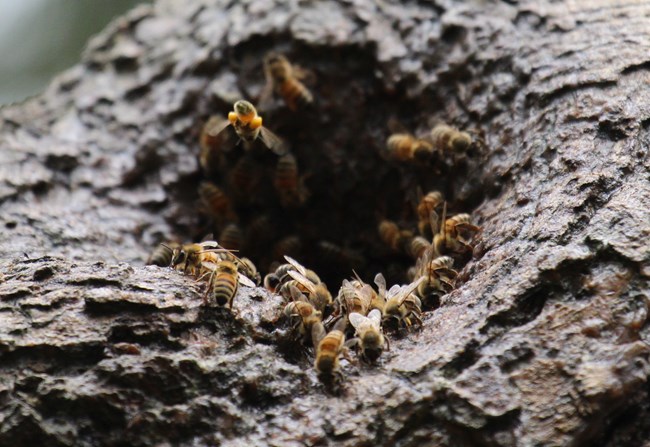
NPS Unlike most species of native bees which prefer rather solitary lifestyles, honeybees exist in hives whose members number in the tens of thousands. That such an “organism” as a hive of individual bees successfully functions as one unit is a result of natural selection honing cooperative behavior in this species to an incredibly high degree. Each hive has one “queen” who is the only reproductive female member of the colony. When she is newly born she will mate with up to twenty “drone” bees (male bees who develop from unfertilized eggs) during her first two weeks of life. The sperm she receives from them (which she stores in a specialized organ called a spermatheca) serves to fertilize all her female offspring (“worker”) bees for the rest of her three or so year lifespan. All told, she will produce upwards of 2,000 eggs per day, more than enough to keep the colony thriving, and then some. Bee eggs go through what is called “complete metamorphosis”, meaning the egg morphs into a larva, then goes through a pupal stage, and finally develops into an adult. The original eggs are laid by the queen in individual hexagonally shaped wax cells in what is known as the brood area of the honeycomb. (The honeycomb is constructed by workers who produce wax scales from the undersides of their abdomens.) The eggs hatch after three days and workers commence feeding the larvae. Just before a larva molts into a pupa, workers apply a wax coating to its cell. After the pupa morphs into an adult, it chews its way out of the cell to begin its life as a member of the hive. This whole sequence takes anywhere from eight to fifteen days depending on what type of bee is being produced- drone, worker, or queen. Drones and workers are fed a “standard” diet of bee bread (a mixture of pollen, honey, and saliva) and honey after the first few days. During the first three days, however, they are fed “royal jelly”, which is a protein and nutrient rich substance made from pollen that’s been digested and secreted from the glands of workers known as “nurse” bees. Now, when a growing colony reaches the point where it needs to split in two, ten to twenty female larvae are fed a “rich” diet of exclusively royal jelly throughout their development. (While these selected few are in the late pupal stage, the mother queen and about two-thirds of the hive leave in a swarm to establish a new colony elsewhere.) The first daughter queen to emerge from her cell will kill her sub-adult siblings, or if more than one daughter queen emerges simultaneously, they will fight until only one survives. It is this one that becomes the new queen and goes on to mate with the drones. The queen is notable for having a longer and plumper abdomen than the other hive members, but all adult bees have bodies that are divided into a head, thorax, and abdomen. The head has two antennae and is where the bee’s compound eyes are located. From its thorax emanate two pairs of wings and three pairs of legs. All adult bees are fairly hairy. While queens lay eggs prodigiously and drones mate on the fly and die, it’s the aptly named worker bees who maintain the colony 24/7. The youngest workers tend the brood cells. When they get older they construct the wax honeycomb, store the hive’s food, and guard the colony entrance- using their barbed stingers connected to a poison sac at the end of their abdomen if necessary. Only the oldest of the workers leave the hive and forage for food. It is these smallest members of the colony that people are most likely to see as they flit about from flower to flower gathering nectar, pollen and water. (Besides collecting pollen on their hairy bodies, they also possess structures on their hind legs called corbicula, or more aptly, pollen baskets.) The workers bring their bounty back to the collective hive. Pollen is the colony’s protein source, while nectar provides its metabolic energy. By ingesting nectar the bees initiate an enzymatic process that is completed by several bees who ingest the regurgitated nectar of the previous bee, until the final bee deposits the chemically altered nectar (now almost honey) into a honeycomb cell. There they fan it with their wings to evaporate the remaining water, resulting in pure golden honey. The bees feed each other this sugary substance, and it serves as their food store through the long winter months. (Honeybees are the only bees that produce honey, by the way.) One wonders how all this coordinated activity is accomplished by organisms with the tiniest of brains. It is known that bees communicate primarily with one another through pheromones, which are “messenger” chemicals produced by glands that can be sensed by other bees. Perhaps even more remarkable is the “dance” performed by workers that lets others know the general direction and distance to an especially abundant food source. As honeybees and other species of social insects are further studied, doubtless further amazing and wonderful facts and details about their lifecycles and behavior will be revealed by science. But in the meantime, just like the Spanish colonists, we have one of nature’s tastiest treats to enjoy, courtesy of the ever busy honeybee. |
Last updated: March 25, 2021
